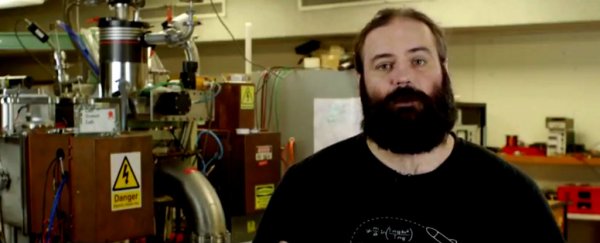An Australian rocket scientist has built a prototype ion drive that could one day power a return trip to Mars using recycled space junk for fuel.
Recent PhD graduate Paddy Neumann made headlines last year when his ion drive obliterated NASA's fuel efficiency record, and just last week, he signed a deal with Europe's biggest aerospace company, Airbus Defence & Space, to launch it to the International Space Station for testing.
The partnership was announced last Thursday at the International Astronautical Congress in Mexico, and marks the first time that Airbus has taken on a customer for the external research platform it plans to install on the International Space Station (ISS) by the end of 2018.
"We've been testing on Earth in a vacuum system to simulate space, but it's a small vacuum system, so this will be the first real test of a true space environment with on-board monitoring of the system," Neumann's co-inventor at the University of Sydney, Marcela Bilek, told ABC News.
In case you haven't heard all the fuss over the so-called Neumann Drive, back in September last year, when Neumann was still a PhD student, he announced that he'd built an ion drive prototype that rivalled NASA's best efforts.
If we can build one that works, ion drives would quite literally revolutionise how we explore our Solar System and beyond, because they don't require massive amounts of fuel to be hauled around space.
Just to give you an idea of how much fuel a regular rocket uses, SpaceX's Falcon 9 rocket needs around 409,500 kg (902,793 pounds) of fuel just to launch itself into space. And the expendable Saturn V rocket used by NASA between 1966 and 1973 needed an incredible 2,076,545 kg (4,578,000 pounds) of fuel.
Imagine how much more they'd need to carry to get a spacecraft 54.6 million km to Mars - and that's a one-way trip.
Instead of our current chemical-based rocket propulsion technology, ion drives are propulsion systems that used a magnetic field to eject ionised - or electrically charged - particles at incredibly high velocity in one direction to propel a spacecraft in the other.
"It works kind of like an arc welder," Neumann told Marcus Strom at The Sydney Morning Herald.
"It throws out metallic ions at high speed and just like there is recoil when a bullet comes out of a gun, the recoil from the plasma moving away gives you thrust, which pushes your spaceship along."
Those ionised particles start out as solid metal, and are electrically heated until they turn into plasma. The trick is to figure out what kinds of material are the most efficient, and Neumann's tests have singled out magnesium.
And you know what's a rich source of magnesium that's already floating around in space? Space junk.
"Much as how whenever humanity has gone to explore some place new, such as Mt. Everest, where we leave oxygen bottles behind, whenever we've gone to space, we've left rubbish behind," he told Vice's Maddison Connaughton. "Somebody should clean it up."
As we reported last year, NASA's record-holder for 'specific impulse' - i.e. fuel-mass to engine-thrust efficiency - at the time was its High Power Electric Propulsion (HiPEP) system, which allows 9,600 (+/- 200) seconds of specific impulse. Neumann's prototype, on the other hand, achieved up to 14,690 (+/- 2,000).
That record helped put Neumann on the map, but as NASA's senior technologist in ion drive technology, Mike Patterson, pointed out last week, that's cute and all, but it means nothing until you can prove it works.
"There is no value, in and of itself, of achieving a 'world-record-specific impulse'," he told The Sydney Morning Herald. "Maximising specific impulse irrespective of other considerations doesn't make any sense. And he would know that."
Ouch.
Patterson is developing NASA's Evolutionary Xenon Thruster, or NEXT, which he claims has more than double the energy efficiency of the Neumann Drive.
"We accept that our current energy efficiency is less than that of xenon-fuelled thrusters, and have ideas on how to improve it with further magnetic nozzle development," Neumann said in response.
The good news for the rest of us who just want to get to Mars already is that Neumann and his team can finally put their money where their mouth is and test this thing in real-life space. Tbh, we don't mind who ends up changing the world with the first functional ion drive, we just want to see someone grow space tomatoes in Mars sand.
Neumann's paper on how solid magnesium fuel provides the best performance was published last month in Applied Physics Letters.
